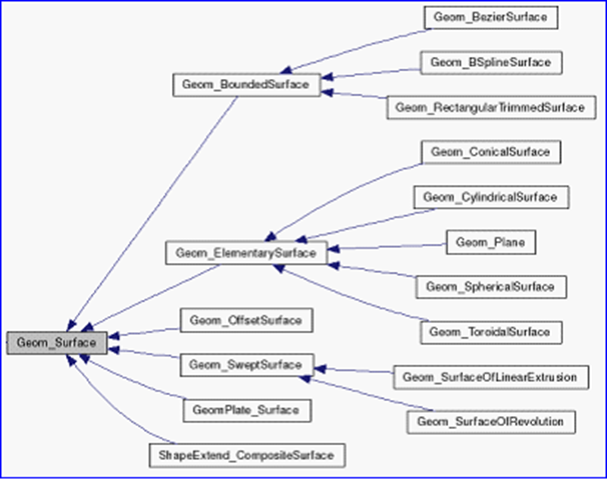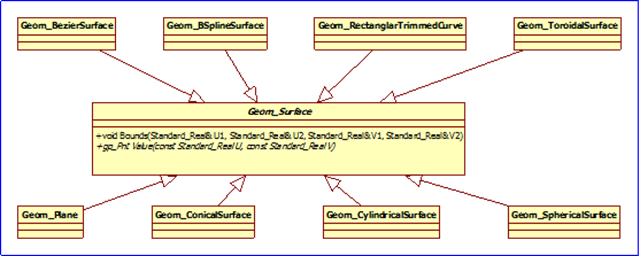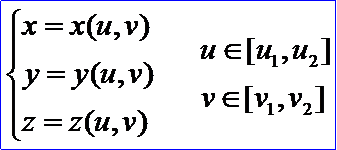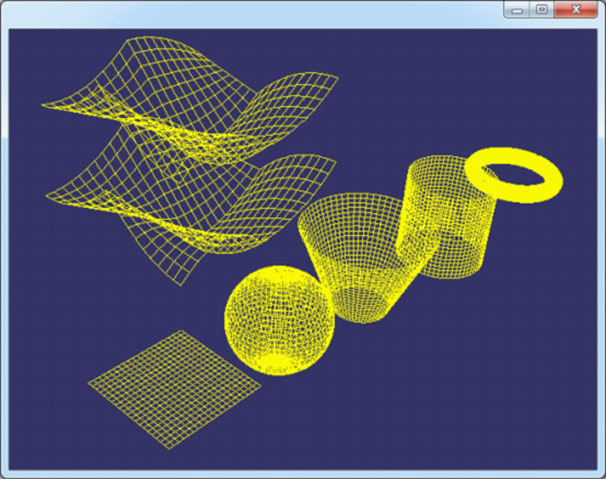Render OpenCascade Geometry Surfaces in OpenSceneGraph
在OpenSceneGraph中绘制OpenCascade的曲面
Render OpenCascade Geometry Surfaces in OpenSceneGraph
摘要Abstract:本文对OpenCascade中的几何曲面数据进行简要说明,并结合OpenSceneGraph将这些曲面显示。
关键字Key Words:OpenCascade、OpenSceneGraph、Geometry Surface、NURBS
一、引言 Introduction
《BRep Format Description White Paper》中对OpenCascade的几何数据结构进行了详细说明。BRep文件中用到的曲面总共有11种:
1.Plane 平面;
2.Cylinder 圆柱面;
3.Cone 圆锥面;
4.Sphere 球面;
5.Torus 圆环面;
6.Linear Extrusion 线性拉伸面;
7.Revolution Surface 旋转曲面;
8.Bezier Surface 贝塞尔面;
9.B-Spline Surface B样条曲面;
10.Rectangle Trim Surface 矩形裁剪曲面;
11.Offset Surface 偏移曲面;
曲面的几何数据类都有一个共同的基类Geom_Surface,类图如下所示:

Figure 1.1 Geometry Surface class diagram
抽象基类Geom_Surface有几个纯虚函数Bounds()、Value()等,可用来计算曲面上的点。类图如下所示:

Figure 1.2 Geom_Surface class diagram
与另一几何内核sgCore中的几何的概念一致,几何(geometry)是用参数方程对曲线曲面精确表示的。
每种曲面都对纯虚函数进行实现,使计算曲面上点的方式统一。
曲线C(u)是单参数的矢值函数,它是由直线段到三维欧几里得空间的映射。曲面是关于两个参数u和v的矢值函数,它表示由uv平面上的二维区域R到三维欧几里得空间的映射。把曲面表示成双参数的形式为:

它的参数方程为:

u,v参数形成了一个参数平面,参数的变化区间在参数平面上构成一个矩形区域。正常情况下,参数域内的点(u,v)与曲面上的点r(u,v)是一一对应的映射关系。
给定一个具体的曲面方程,称之为给定了一个曲面的参数化。它既决定了所表示的曲面的形状,也决定了该曲面上的点与其参数域内的点的一种对应关系。同样地,曲面的参数化不是唯一的。
曲面双参数u,v的变化范围往往取为单位正方形,即u∈[0,1],v∈[0,1]。这样讨论曲面方程时,即简单、方便,又不失一般性。
二、程序示例 Code Example
使用函数Value(u, v)根据参数计算出曲面上的点,将点分u,v方向连成线,可以绘制出曲面的线框模型。程序如下所示:
- /*
- * Copyright (c) 2013 eryar All Rights Reserved.
- *
- * File : Main.cpp
- * Author : eryar@163.com
- * Date : 2013-08-11 10:36
- * Version : V1.0
- *
- * Description : Draw OpenCascade Geometry Surfaces in OpenSceneGraph.
- *
- */
- // OpenSceneGraph
- #include <osgDB/ReadFile>
- #include <osgViewer/Viewer>
- #include <osgGA/StateSetManipulator>
- #include <osgViewer/ViewerEventHandlers>
- #pragma comment(lib, "osgd.lib")
- #pragma comment(lib, "osgDBd.lib")
- #pragma comment(lib, "osgGAd.lib")
- #pragma comment(lib, "osgViewerd.lib")
- // OpenCascade
- #define WNT
- #include <TColgp_Array2OfPnt.hxx>
- #include <TColStd_HArray1OfInteger.hxx>
- #include <TColGeom_Array2OfBezierSurface.hxx>
- #include <GeomConvert_CompBezierSurfacesToBSplineSurface.hxx>
- #include <Geom_Surface.hxx>
- #include <Geom_BezierSurface.hxx>
- #include <Geom_BSplineSurface.hxx>
- #include <Geom_ConicalSurface.hxx>
- #include <Geom_CylindricalSurface.hxx>
- #include <Geom_Plane.hxx>
- #include <Geom_ToroidalSurface.hxx>
- #include <Geom_SphericalSurface.hxx>
- #pragma comment(lib, "TKernel.lib")
- #pragma comment(lib, "TKMath.lib")
- #pragma comment(lib, "TKG3d.lib")
- #pragma comment(lib, "TKGeomBase.lib")
- // Approximation Delta.
- const double APPROXIMATION_DELTA = 0.1;
- /**
- * @breif Build geometry surface.
- */
- osg::Node* buildSurface(const Geom_Surface& surface)
- {
- osg::ref_ptr<osg::Geode> geode = new osg::Geode();
- gp_Pnt point;
- Standard_Real uFirst = 0.0;
- Standard_Real vFirst = 0.0;
- Standard_Real uLast = 0.0;
- Standard_Real vLast = 0.0;
- surface.Bounds(uFirst, uLast, vFirst, vLast);
- Precision::IsNegativeInfinite(uFirst) ? uFirst = -1.0 : uFirst;
- Precision::IsInfinite(uLast) ? uLast = 1.0 : uLast;
- Precision::IsNegativeInfinite(vFirst) ? vFirst = -1.0 : vFirst;
- Precision::IsInfinite(vLast) ? vLast = 1.0 : vLast;
- // Approximation in v direction.
- for (Standard_Real u = uFirst; u <= uLast; u += APPROXIMATION_DELTA)
- {
- osg::ref_ptr<osg::Geometry> linesGeom = new osg::Geometry();
- osg::ref_ptr<osg::Vec3Array> pointsVec = new osg::Vec3Array();
- for (Standard_Real v = vFirst; v <= vLast; v += APPROXIMATION_DELTA)
- {
- point = surface.Value(u, v);
- pointsVec->push_back(osg::Vec3(point.X(), point.Y(), point.Z()));
- }
- // Set the colors.
- osg::ref_ptr<osg::Vec4Array> colors = new osg::Vec4Array;
- colors->push_back(osg::Vec4(1.0f, 1.0f, 0.0f, 0.0f));
- linesGeom->setColorArray(colors.get());
- linesGeom->setColorBinding(osg::Geometry::BIND_OVERALL);
- // Set the normal in the same way of color.
- osg::ref_ptr<osg::Vec3Array> normals = new osg::Vec3Array;
- normals->push_back(osg::Vec3(0.0f, -1.0f, 0.0f));
- linesGeom->setNormalArray(normals.get());
- linesGeom->setNormalBinding(osg::Geometry::BIND_OVERALL);
- // Set vertex array.
- linesGeom->setVertexArray(pointsVec);
- linesGeom->addPrimitiveSet(new osg::DrawArrays(osg::PrimitiveSet::LINE_STRIP, , pointsVec->size()));
- geode->addDrawable(linesGeom.get());
- }
- // Approximation in u direction.
- for (Standard_Real v = vFirst; v <= vLast; v += APPROXIMATION_DELTA)
- {
- osg::ref_ptr<osg::Geometry> linesGeom = new osg::Geometry();
- osg::ref_ptr<osg::Vec3Array> pointsVec = new osg::Vec3Array();
- for (Standard_Real u = vFirst; u <= uLast; u += APPROXIMATION_DELTA)
- {
- point = surface.Value(u, v);
- pointsVec->push_back(osg::Vec3(point.X(), point.Y(), point.Z()));
- }
- // Set the colors.
- osg::ref_ptr<osg::Vec4Array> colors = new osg::Vec4Array;
- colors->push_back(osg::Vec4(1.0f, 1.0f, 0.0f, 0.0f));
- linesGeom->setColorArray(colors.get());
- linesGeom->setColorBinding(osg::Geometry::BIND_OVERALL);
- // Set the normal in the same way of color.
- osg::ref_ptr<osg::Vec3Array> normals = new osg::Vec3Array;
- normals->push_back(osg::Vec3(0.0f, -1.0f, 0.0f));
- linesGeom->setNormalArray(normals.get());
- linesGeom->setNormalBinding(osg::Geometry::BIND_OVERALL);
- // Set vertex array.
- linesGeom->setVertexArray(pointsVec);
- linesGeom->addPrimitiveSet(new osg::DrawArrays(osg::PrimitiveSet::LINE_STRIP, , pointsVec->size()));
- geode->addDrawable(linesGeom.get());
- }
- return geode.release();
- }
- /**
- * @breif Test geometry surfaces of OpenCascade.
- */
- osg::Node* buildScene(void)
- {
- osg::ref_ptr<osg::Group> root = new osg::Group();
- // Test Plane.
- Geom_Plane plane(gp::XOY());
- root->addChild(buildSurface(plane));
- // Test Bezier Surface and B-Spline Surface.
- TColgp_Array2OfPnt array1(,,,);
- TColgp_Array2OfPnt array2(,,,);
- TColgp_Array2OfPnt array3(,,,);
- TColgp_Array2OfPnt array4(,,,);
- array1.SetValue(,,gp_Pnt(,,));
- array1.SetValue(,,gp_Pnt(,,));
- array1.SetValue(,,gp_Pnt(,,));
- array1.SetValue(,,gp_Pnt(,,));
- array1.SetValue(,,gp_Pnt(,,));
- array1.SetValue(,,gp_Pnt(,,));
- array1.SetValue(,,gp_Pnt(,,));
- array1.SetValue(,,gp_Pnt(,,));
- array1.SetValue(,,gp_Pnt(,,));
- array2.SetValue(,,gp_Pnt(,,));
- array2.SetValue(,,gp_Pnt(,,));
- array2.SetValue(,,gp_Pnt(,,));
- array2.SetValue(,,gp_Pnt(,,));
- array2.SetValue(,,gp_Pnt(,,));
- array2.SetValue(,,gp_Pnt(,,));
- array2.SetValue(,,gp_Pnt(,,));
- array2.SetValue(,,gp_Pnt(,,));
- array2.SetValue(,,gp_Pnt(,,));
- array3.SetValue(,,gp_Pnt(,,));
- array3.SetValue(,,gp_Pnt(,,));
- array3.SetValue(,,gp_Pnt(,,));
- array3.SetValue(,,gp_Pnt(,,));
- array3.SetValue(,,gp_Pnt(,,));
- array3.SetValue(,,gp_Pnt(,,));
- array3.SetValue(,,gp_Pnt(,,));
- array3.SetValue(,,gp_Pnt(,,));
- array3.SetValue(,,gp_Pnt(,,));
- array4.SetValue(,,gp_Pnt(,,));
- array4.SetValue(,,gp_Pnt(,,));
- array4.SetValue(,,gp_Pnt(,,));
- array4.SetValue(,,gp_Pnt(,,));
- array4.SetValue(,,gp_Pnt(,,));
- array4.SetValue(,,gp_Pnt(,,));
- array4.SetValue(,,gp_Pnt(,,));
- array4.SetValue(,,gp_Pnt(,,));
- array4.SetValue(,,gp_Pnt(,,));
- Geom_BezierSurface BZ1(array1);
- Geom_BezierSurface BZ2(array2);
- Geom_BezierSurface BZ3(array3);
- Geom_BezierSurface BZ4(array4);
- root->addChild(buildSurface(BZ1));
- root->addChild(buildSurface(BZ2));
- root->addChild(buildSurface(BZ3));
- root->addChild(buildSurface(BZ4));
- Handle_Geom_BezierSurface BS1 = new Geom_BezierSurface(array1);
- Handle_Geom_BezierSurface BS2 = new Geom_BezierSurface(array2);
- Handle_Geom_BezierSurface BS3 = new Geom_BezierSurface(array3);
- Handle_Geom_BezierSurface BS4 = new Geom_BezierSurface(array4);
- TColGeom_Array2OfBezierSurface bezierarray(,,,);
- bezierarray.SetValue(,,BS1);
- bezierarray.SetValue(,,BS2);
- bezierarray.SetValue(,,BS3);
- bezierarray.SetValue(,,BS4);
- GeomConvert_CompBezierSurfacesToBSplineSurface BB (bezierarray);
- if (BB.IsDone())
- {
- Geom_BSplineSurface BSPLSURF(
- BB.Poles()->Array2(),
- BB.UKnots()->Array1(),
- BB.VKnots()->Array1(),
- BB.UMultiplicities()->Array1(),
- BB.VMultiplicities()->Array1(),
- BB.UDegree(),
- BB.VDegree() );
- BSPLSURF.Translate(gp_Vec(,,));
- root->addChild(buildSurface(BSPLSURF));
- }
- // Test Spherical Surface.
- Geom_SphericalSurface sphericalSurface(gp::XOY(), 1.0);
- sphericalSurface.Translate(gp_Vec(2.5, 0.0, 0.0));
- root->addChild(buildSurface(sphericalSurface));
- // Test Conical Surface.
- Geom_ConicalSurface conicalSurface(gp::XOY(), M_PI/, 1.0);
- conicalSurface.Translate(gp_Vec(5.0, 0.0, 0.0));
- root->addChild(buildSurface(conicalSurface));
- // Test Cylindrical Surface.
- Geom_CylindricalSurface cylindricalSurface(gp::XOY(), 1.0);
- cylindricalSurface.Translate(gp_Vec(8.0, 0.0, 0.0));
- root->addChild(buildSurface(cylindricalSurface));
- // Test Toroidal Surface.
- Geom_ToroidalSurface toroidalSurface(gp::XOY(), 1.0, 0.2);
- toroidalSurface.Translate(gp_Vec(11.0, 0.0, 0.0));
- root->addChild(buildSurface(toroidalSurface));
- return root.release();
- }
- int main(int argc, char* argv[])
- {
- osgViewer::Viewer myViewer;
- myViewer.setSceneData(buildScene());
- myViewer.addEventHandler(new osgGA::StateSetManipulator(myViewer.getCamera()->getOrCreateStateSet()));
- myViewer.addEventHandler(new osgViewer::StatsHandler);
- myViewer.addEventHandler(new osgViewer::WindowSizeHandler);
- return myViewer.run();
- }
程序效果如下图所示:

Figure 2.1 OpenCascade Geometry Surfaces in OpenSceneGraph
三、结论 Conclusion
根据OpenCascade中的几何曲面的函数Value(u, v)可以计算出曲面上的点。分u方向和v方向分别绘制曲面上的点,并将之连接成线,即可以表示出曲面的线框模型。因为这样的模型没有面的信息,所以不能有光照效果、材质效果等。要有光照、材质的信息,必须将曲面进行三角剖分。相关的剖分算法有Delaunay三角剖分等。
PDF Version: Draw OpenCascade Geometry Surfaces in OpenSceneGraph
Render OpenCascade Geometry Surfaces in OpenSceneGraph的更多相关文章
- Render OpenCascade Geometry Curves in OpenSceneGraph
在OpenSceneGraph中绘制OpenCascade的曲线 Render OpenCascade Geometry Curves in OpenSceneGraph eryar@163.com ...
- OpenCascade Shape Representation in OpenSceneGraph
OpenCascade Shape Representation in OpenSceneGraph eryar@163.com 摘要Abstract:本文通过程序实例,将OpenCascade中的拓 ...
- Opencascade、OpenGL和OpenSceneGraph的区别与联系
OpenGL只是三维显示 Openscenegraph基于场景图的概念,它提供一个在OpenGL之上的面向对象的框架,从而能把开发者从实现和优化底层图形的调用中解脱出来 Opencascade更适合算 ...
- OpenCASCADE Linear Extrusion Surface
OpenCASCADE Linear Extrusion Surface eryar@163.com Abstract. OpenCASCADE linear extrusion surface is ...
- Polynomial Library in OpenCascade
Polynomial Library in OpenCascade eryar@163.com 摘要Abstract:分析幂基曲线即多项式曲线在OpenCascade中的计算方法,以及利用OpenSc ...
- Representation Data in OpenCascade BRep
Representation Data in OpenCascade BRep eryar@163.com 摘要Abstract:现在的显示器大多数是光栅显示器,即可以看做一个像素的矩阵.在光栅显示器 ...
- Open Cascade 转化为OpenSceneGraph中的Mesh
#include <osgDB/ReadFile> #include <osgViewer/Viewer> #include <osgGA/StateSetManipul ...
- OpenCASCADE Data Exchange - 3D PDF
OpenCASCADE Data Exchange - 3D PDF eryar@163.com Abstract. Today most 3D engineering model data are ...
- Visualize Surface by Delaunay Triangulator
Visualize Surface by Delaunay Triangulator eryar@163.com Abstract. Delaunay Triangulation is the cor ...
随机推荐
- linux bash中too many arguments问题的解决方法
今天在编写shell脚本时,在if条件后跟的是[ $pid ],执行脚本的时候报 然后我输入改为[[$pid]]后,再执行脚本,就成功了,代码如下: #!/bin/bash pid=`ps -ef|g ...
- 举例详解CSS中的cursor属性
这篇文章主要举例介绍了CSS中的cursor属性,包括zoom-in/zoom-out和grab/grabbing等常用属性值的使用,需要的朋友可以参考下 一.开篇之言 CSS3的领域范围已经渗透到了 ...
- java.lang.RuntimeException: Method setUp in android.test.ApplicationTestCase not mocked. See http://g.co/androidstudio/not-mocked for details.
解决: build.gradle里加入: android { testOptions { unitTests.returnDefaultValues = true } }
- 浅谈Swift集合类型
Swift 的集合表现形式由数组和字典组成.它可以完美的存储任何呢想存储的东西. 数组是一个同类型的序列化列表集合,它用来存储相同类型的不同值.字典也是一个数组,但它的存值方式类似于Map,通过一对一 ...
- selenium 富文本框处理
selenium 富文本框处理, 网上有用API的解决方法1:参见:http://blog.csdn.net/xc5683/article/details/8963621 群里1位群友的解决方法2:参 ...
- Entity Framework EF6使用 MySql创建数据库异常解决办法
EF6使用MySQL数据库时,第一次创建数据库出现“Specified key was too long; max key length is 767 bytes”错误,解决办法请见以下连接. htt ...
- php小trick
1.unset函数是注销变量函数2.mysql 绕过截断单引号 (1)(php单引号不解析,双引号解析)$query='select * from flag where user=\''.$user[ ...
- 初学python里的yield send next
今天看书的时候突然看到这个想起来一直没有怎么使用过send和next试了一下 发现了一个诡异的问题 import math def get_primes(start): while 1 : if is ...
- 淘宝上倒卖新浪微盘事件来龙去脉——谈谈巧用IMEI
这是一个老黄历的事件,曾记得淘宝上的卖家卖10元卖50g网络硬盘,并且卖的相当的火,一个月就卖了500个账号.由于我也是那个事件的亲身经历者之一,这里就看到了IMEI号在项目中防止作弊是何其的重要. ...
- mono的远程调试
mono可以让.net程序运行在linux平台上.于是.net程序员有了mono之后就转身跨平台了.但开放环境往往还是在windows下,于是有了这样的需求,是否可以用windows下的源码来实机调试 ...
